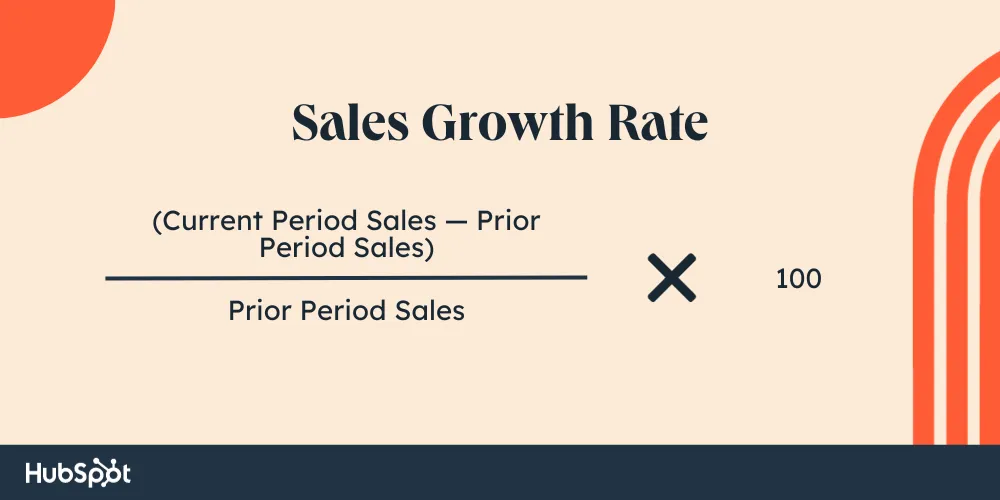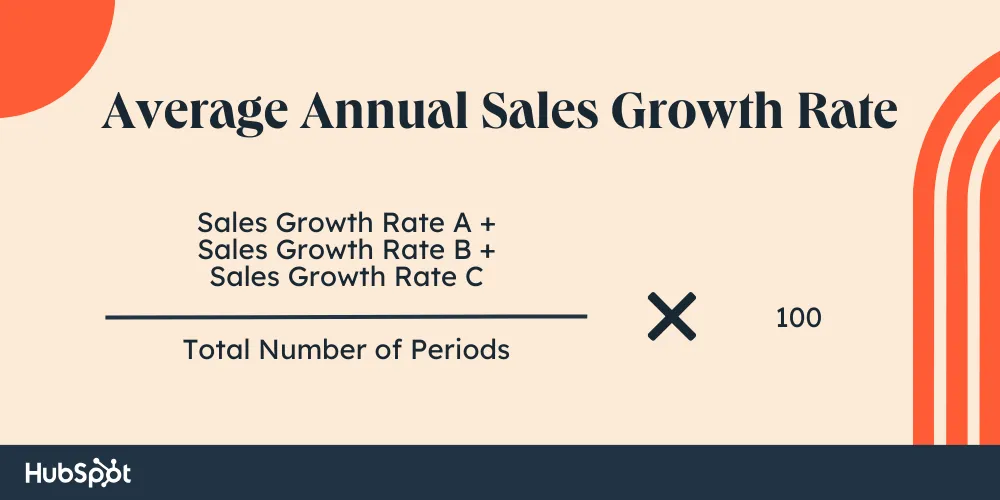For companies that are focused on growing and scaling, an essential metric to keep an eye on is the sales growth rate.
Understanding the sales growth rate is a critical metric that empowers companies to make data-informed decisions. If this rate decreases compared to prior periods, that can be an indication that the sales team needs to take a different approach to drive revenue growth. Conversely, a high sales growth rate is often seen as a good sign for company stakeholders.
Now that we understand what sales growth rate tells us, let’s review how to calculate it.
Sales Growth Rate Formula
To calculate the sales growth rate for your business, you’ll need to know the net sales value of the initial period and the net sales value of the current period. These values should be easy to find on an income statement. Once you have these values, you can use the following formula:

Let’s walk through an example of how to apply the sales growth rate formula.
Serial Juice Co. is a startup that delivers custom-pressed fruit and vegetable juices to its customers. The Serial Juice Co. sales team wanted to measure their sales growth rate from their fiscal year that ended April 30, 2021, to their fiscal year that ended on April 30, 2022.
During the fiscal year that ended on April 30, 2021, the company reported bringing in $750,000 in sales. The following year, they reported bringing in $1,000,000 in sales. Let’s use the sales growth rate formula with these figures.
Sales Growth Rate = ($1,000,000 — $750,000) / $750,000 * 100 = 33%
That means Serial Juice Co. had a sales growth rate of 33% during this time period.
Keep track of your own sales growth with our convenient sales reporting tools and software provided by HubSpot.
Average Annual Sales Growth Rate
When assessing sales growth rate, many companies choose to measure how much their sales have grown over a number of years, which is known as the average annual sales growth rate.
To measure your company’s sales growth performance over a number of years, begin by using the previous formula to calculate the sales growth rate of each year you would like to assess. Once you have those values, you can use the following formula:

Let’s apply this to an example. The company in question — let’s call it GSD Company — would like to measure its average annual sales growth rate over the past four years. Here are the annual sales values and growth rate year over year for GSD Company:
|
YEAR |
REVENUE |
GROWTH RATE |
|
2018 |
$950,000 |
|
|
2019 |
$1,000,000 |
5.26% |
|
2020 |
$1,125,000 |
12.5% |
|
2021 |
$1,200,000 |
6.67% |
|
2022 |
$1,400,000 |
16.7% |
Now let’s apply these values to the average annual sales growth formula:
Average Annual Sales Growth Rate =
(5.26% + 12.5% + 6.67% + 16.7%) / 4 Years = 10.28%
From 2018 to 2022, GSD company had an annual sales growth rate of 10.28%.
What is a good sales growth rate?
There are no hard and fast values that indicate a “good” or “bad” sales growth rate because the rate of growth is relative for each company. Here are a few factors that can impact how much a company can expect to see sales growth from year to year.
Company Size
A small business may experience a higher sales growth rate than a larger business because a small business is working with smaller dollar values. Therefore, it takes fewer sales to influence a change.
For example, a small company that pulls in $500,000 in revenue one year, and $750,000 of revenue the next year. That’s a sales growth rate of 33%.
A large company that brings in $10 million in sales one year and $12 million in sales the next year has a sales growth rate of 20%. Though the actual sales growth rate for the larger company is lower, this company had to bring in significantly more money than the smaller company.
Competitive Landscape
A successful sales growth rate can also depend on how well a company’s competitors are performing and the overall growth of its industry.
In 2022, U.S. ecommerce sales grew by 7.7% from the prior year, and retail sales decreased by 37.3%. With these figures in mind, companies that sell products and services online likely saw higher individual sales growth rates than retail companies because, at an industry level, there were more opportunities for growth for ecommerce companies.
Sales Goals
Lastly, a successful sales growth rate will largely depend on the unique sales goals of the company. Each company has its own set of goals and strategies that are highly influenced by the factors above, as well as the company’s leadership, stakeholders, and sales team bandwidth.
Understanding sales growth rates can provide valuable insight into your company's current and future performance. Check out The Ultimate Guide to Sales Metrics to discover what other valuable sales metrics your team should be measuring.
Do Your Due Diligence
Having a successful sales growth is going to be largely dependent on the commitment to keeping track of the company’s growth by using the various tools for tracking by Hubspot and other providers. Make sure the products you’re selling are contributing to that goal. Have a set number that you would like to reach and start moving towards that goal. Use the tools you choose to keep track of that growth and make calculated adjustments as needed.
As mentioned previously, keeping track of competitor growth in your field can be equally important. By no means are we saying to copy anyone. However, keep an eye on where other companies are excelling and then compare them to your current position. Follow the guidelines we have laid out here, and you will find the experience is much easier than it may seem.
Sales Metrics
.png?width=112&height=112&name=Image%20Hackathon%20%E2%80%93%20Square%20(14).png)






![Sales Metrics: What to Track, How to Track, & Why [Expert Tips]](https://53.fs1.hubspotusercontent-na1.net/hubfs/53/sales-metrics.webp)




![Understanding Sales Variance [Formula + Examples]](https://53.fs1.hubspotusercontent-na1.net/hubfs/53/Sales%20Variance.png)